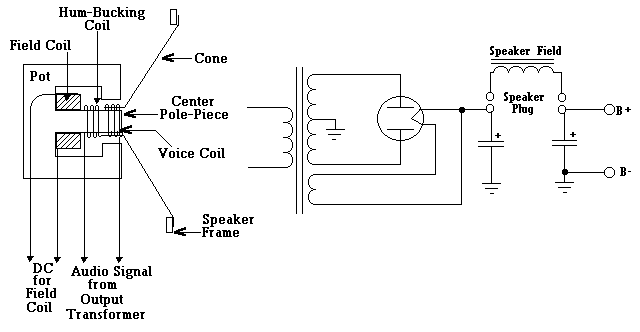Electromagnetic dynamic speakers have a field coil that is wound on the center pole-piece which is part of the speaker pot. (See Diagram)
The field coil is often used as the filter choke of the receiver power supply. The DC current passing through the field coil creates a strong magnetic field to operate the speaker. Because the field coil is used as the filter choke, it can have a high hum component. This hum component affects the voice coil causing it to be heard in the speaker. To reduce this hum a hum-bucking coil, consisting of a few turns of wire, is wound on the pole-piece and stationary to the field coil. The hum-bucking coil is in series with the voice coil and connected in such a manner that any AC component induced in the voice coil by the field coil is out of phase with the AC component induced in the hum-bucking coil, and the two will tend to cancel out reducing the hum. If the hum-bucking coil leads have been disconnected and then reconnected so that it is in phase with the voice coil, the AC component will be reinforced and the hum level increased.
Some receivers with electromagnetic dynamic speakers may have the speaker leads terminated in a plug, which plugs into a mating socket on the receiver chassis.
Be sure to have this plug inserted before applying power otherwise damage to the first electrolytic filter capacitor may occur. The reason for this is that without the field coil in the circuit, there is no load on the output of the rectifier tube. This no-load condition will allow the electrolytic capacitor that is connected directly to the output of the rectifier to charge up to the peak voltage of the high-voltage secondary, which may exceed the maximum rated voltage of the capacitor.
If the field coil winding is defective, the speaker will no longer function properly. The options are; repair the field coil, find another field coil replacement speaker, or replace the speaker with a permanent magnet (pm) type.
The field coil is often used as the filter choke of the receiver power supply. The DC current passing through the field coil creates a strong magnetic field to operate the speaker. Because the field coil is used as the filter choke, it can have a high hum component. This hum component affects the voice coil causing it to be heard in the speaker. To reduce this hum a hum-bucking coil, consisting of a few turns of wire, is wound on the pole-piece and stationary to the field coil. The hum-bucking coil is in series with the voice coil and connected in such a manner that any AC component induced in the voice coil by the field coil is out of phase with the AC component induced in the hum-bucking coil, and the two will tend to cancel out reducing the hum. If the hum-bucking coil leads have been disconnected and then reconnected so that it is in phase with the voice coil, the AC component will be reinforced and the hum level increased.
Some receivers with electromagnetic dynamic speakers may have the speaker leads terminated in a plug, which plugs into a mating socket on the receiver chassis.
Be sure to have this plug inserted before applying power otherwise damage to the first electrolytic filter capacitor may occur. The reason for this is that without the field coil in the circuit, there is no load on the output of the rectifier tube. This no-load condition will allow the electrolytic capacitor that is connected directly to the output of the rectifier to charge up to the peak voltage of the high-voltage secondary, which may exceed the maximum rated voltage of the capacitor.
If the field coil winding is defective, the speaker will no longer function properly. The options are; repair the field coil, find another field coil replacement speaker, or replace the speaker with a permanent magnet (pm) type.







